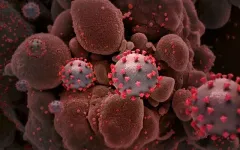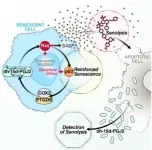(Press-News.org) James McKerrow, MD, PhD, dean of the Skaggs School of Pharmacy and Pharmaceutical Sciences at University of California San Diego, has long studied neglected tropical diseases -- chronic and disabling parasitic infections that primarily affect poor and underserved communities in developing nations. They're called "neglected" because there is little financial incentive for pharmaceutical companies to develop therapies for them.
One of these neglected diseases is Chagas disease, the leading cause of heart failure in Latin America, which is spread by "kissing bugs" carrying the parasite Trypanosoma cruzi. These parasites produce an enzyme called cruzain that helps them replicate and evade the human immune system. McKerrow's research team looks for inhibitors of cruzain -- small molecules that might form the basis for new anti-parasitic medicines. One particularly effective cruzain inhibitor is called K777.
Then, in the spring of 2020, the COVID-19 pandemic began to sweep through the United States. Researchers quickly reported that SARS-CoV-2, the coronavirus that causes COVID-19, can't dock on and infect human cells unless a human enzyme called cathepsin L cleaves the virus' spike protein.
And it just so happens that cathepsin L looks and acts a lot like cruzain.
In a study published March 31, 2021 by ACS Chemical Biology, McKerrow and team show that low concentrations of K777 inhibit cathepsin L can reduce SARS-CoV-2's ability to infect four host cell lines, without harming the cells.
"Since K777 inhibits a human enzyme, not the virus itself, it's our hope that it's less likely the virus will evolve resistance against it," said McKerrow, co-senior author of the study with Thomas Meek, PhD, of Texas A&M University.
K777 wasn't equally effective in all cell lines. That's likely because not all cell lines produced the same amount of cathepsin L or the same amount of ACE2, the host cell receptor that the virus' spike protein uses to latch onto cells after it's cleaved by cathepsin L. The inhibitor was best at preventing SARS-CoV-2 infection in the cells that produced the most cathepsin L and ACE2.
The cell lines tested were derived from African green monkey kidney epithelium, human cervical epithelium and two types of human lung epithelium. While an important research tool, cell lines such as these are not necessarily representative of patients. They are easy to grow and manipulate in research laboratories because they are cancer cells, but that also means their molecular features likely differ from the average person's healthy lung or cervical cells.
"We were surprised at just how effective K777 is in blocking viral infection in the lab," McKerrow said. "Yet under usual circumstances it would be impractical and unlikely that we ourselves would be able to move the compound so quickly into clinical trials. We're fortunate that an 'entrepreneur-in-residence' program here at UC San Diego has helped bridge that gap."
Selva Therapeutics, a privately held biotechnology company, has licensed K777 from UC San Diego. In parallel with this study, the company has also found that the experimental therapeutic prevented lung damage in COVID-19 animal models and was well-tolerated by people who participated in a Phase I clinical trial to assess safety. Selva is planning a Phase IIa clinical trial in non-hospitalized COVID-19 patients for late 2021.
Many people with COVID-19 experience mild disease and can recover at home with supportive care to help relieve their symptoms. Currently, severe cases of COVID-19 may be treated with the antiviral drug remdesivir, approved by the U.S. Food and Drug Administration (FDA) for use in hospitalized patients, or a medication that has received emergency use authorization from the FDA, such as monoclonal antibodies. Worldwide, more than 124 million people have been diagnosed with COVID-19 and 2.72 million have died from the infection.
INFORMATION:
Co-authors of the study include: Drake M. Mellott, Bala C. Chenna, Demetrios H. Kostomiris, Jiyun Zhu, Zane W. Taylor, Klaudia I. Kocurek, Ardala Katzfuss, Linfeng Li, Frank M. Raushel, Texas A&M University; Chien-Te Tseng, Aleksandra Drelich, Jason Hsu, Vivian Tat, University of Texas; Pavla Fajtová, UC San Diego and Academy of Sciences of the Czech Republic; Miriam A. Giardini, Danielle Skinner, Ken Hirata, Michael C. Yoon, Sungjun Beck, Aaron F. Carlin, Alex E. Clark, Laura Beretta, Vivian Hook, Anthony J. O'Donoghue, Jair Lage de Siqueira-Neto, UC San Diego; Daniel Maneval, Felix Frueh, Selva Therapeutics; Brett L. Hurst, and Hong Wang, Utah State University.
Disclosure: James McKerrow is an advisor to and holds stock shares in Selva Therapeutics, Inc.
A novel mechanism has been identified that might explain why a rare mutation is associated with familial Alzheimer's disease in a new study by investigators at the University of Chicago. The paper, published on April 2 in the Journal of Experimental Medicine, characterizes a mutation located in a genetic region that was not previously thought be pathogenic, upending assumptions about what kinds of mutations can be associated with Alzheimer's Disease.
Alzheimer's, a neurodegenerative disease that currently affects more than 6 million Americans, has ...
Buck Institute researchers have discovered and are developing a novel, non-invasive biomarker test that can be used to measure and track performance of senolytics: a class of drugs that selectively eliminate senescent cells. The discovery is expected to play a major role in efforts to develop treatments that would battle a myriad of chronic age-related conditions that range from arthritis to lung disease to Alzheimer's disease and glaucoma. This biomarker is a unique signaling lipid metabolite, normally exclusively intracellular, but is released when senescent cells are forced to die. This metabolite is detectible in blood and urine, making non-invasive ...
Gasoline, the primary transportation fuel, contains hydrocarbons with 5-11 carbons (C5-11) and is almost derived from petroleum at present.
Gasoline can also be produced from non-petroleum syngas. Nonetheless, achieving high conversions of syngas to C5-11 with excellent selectivity and stability remains a challenge.
A research group led by Prof. LIU Zhongmin and Prof. ZHU Wenliang from the Dalian Institute of Chemical Physics (DICP) of the Chinese Academy of Sciences realized highly efficient and selective conversion of syngas to gasoline-range liquid hydrocarbons over a dual-bed catalyst.
The study was published in Chem Catalysis on April 2.
This dual-bed catalyst, (CZA +Al2O3)/N-ZSM-5(97), consists ...
Up to one in five employees at an academic medical institution are considering leaving their professions due to the strains of coping with the pandemic in their own lives, according to a new University of Utah Health study. Individuals who had caregiving responsibilities were among those most likely to contemplate leaving or reducing hours.
The findings suggest that retaining highly trained doctors, nurses, and scientists in the aftermath of the COVID-19 pandemic could be the next great health care challenge.
"It's sobering to learn that, during a time of economic recession, at least one-fifth of our workforce were considering leaving their jobs because of the severe levels of stress they were experiencing," says Angela Fagerlin, Ph.D., the study's senior author and professor ...
SAN FRANCISCO, CA (April 2, 2021) -- In recent years, advancements in DNA sequencing have exposed a large amount of hidden diversity in reef-building corals: species that appear identical to one another but are genetically distinct. Typically ignored as they are invisible to the naked eye, a team of researchers at the California Academy of Sciences and The University of Queensland, along with over a dozen international collaborators, is taking a more holistic approach to understand these hidden species by investigating overlooked ecological differences that have wide-ranging implications for the vulnerability and resilience of reef-building corals. The team hopes that their findings, ...
What The Study Did: This survey study examined the career development, productivity, childcare needs and likelihood of leaving the workforce among employees at an academic medical center during the COVID-19 pandemic.
Authors: Angela Fagerlin, Ph.D., of the University of Utah in Salt Lake City, is the corresponding author.
To access the embargoed study: Visit our For The Media website at this link https://media.jamanetwork.com/
(doi:10.1001/jamanetworkopen.2021.3997)
Editor's Note: The article includes conflicts of interest and funding/support disclosures. Please see the article for additional information, including other authors, author contributions and affiliations, conflict of interest and financial disclosures, and funding ...
What The Study Did: Researchers compared rates of health maintenance organization (HMO) enrollment, by race and ethnicity, for children with commercial and public coverage with the use of national survey data.
Authors: Alon Peltz, M.D., M.B.A., M.H.S., of Harvard Medical School in Boston, is the corresponding author.
To access the embargoed study: Visit our For The Media website at this link https://media.jamanetwork.com/
(doi:10.1001/jamanetworkopen.2021.4162)
Editor's Note: The article includes conflicts of interest and funding/support disclosures. Please see the article for additional ...
Extended surges in the South and West in the summer and early winter of 2020 resulted in regional increases in excess death rates, both from COVID-19 and from other causes, a 50-state analysis of excess death trends has found. Virginia Commonwealth University researchers' latest study notes that Black Americans had the highest excess death rates per capita of any racial or ethnic group in 2020.
The research, publishing Friday in the Journal of the American Medical Association, offers new data from the last 10 months of 2020 on how many Americans died during 2020 as a result of the effects of the pandemic -- beyond the number of COVID-19 deaths alone -- and which states and racial groups were hit hardest.
The rate of excess deaths -- or deaths above the number that ...
More than 60% of U.S. adults who vape are interested in quitting, according to a study published today in JAMA Network Open by MUSC Hollings Cancer Center researchers. And among those who vape to help them to quit smoking, some are successful while others continue smoking and using electronic cigarettes.
The study, which analyzed longitudinal survey data from more than 30,000 adults across the country, aimed to provide the most up-to-date estimate of how many Americans are interested in stopping their use of e-cigarettes or have made past attempts to quit.
According to the findings, former cigarette smokers had the highest intentions and interest in quitting. This is likely due to an increasing number of smokers using e-cigarettes to transition away from cigarettes, said the study's authors.
While ...
What The Study Did: This study updates an analysis of deaths in the United States in 2020, including deaths due to COVID-19 as well as all other causes.
Authors: Steven H. Woolf, M.D., M.P.H., of the Virginia Commonwealth University School of Medicine in Richmond, is the corresponding author.
To access the embargoed study: Visit our For The Media website at this link https://media.jamanetwork.com/
(doi:10.1001/jama.2021.5199)
Editor's Note: The article includes funding/support disclosures. Please see the article for additional information, including other ...





